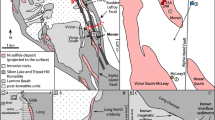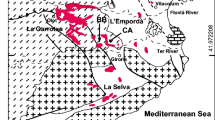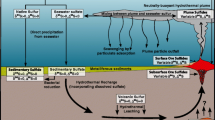Abstract
The Ming deposit is an early Ordovician, bimodal-mafic Cu–Au volcanogenic massive sulphide (VMS) deposit in the Newfoundland Appalachians that was metamorphosed to upper greenschist/lower amphibolite facies conditions and deformed in the Silurian and Devonian. The Ming deposit consists of several spatially proximal ore bodies of which the 1806 Zone, 1807 Zone, Ming South Up Plunge and Down Plunge and the Lower Footwall Zone are the focus of this paper. The ore bodies have similar stratigraphic sequences. The ore bodies can be divided into (1) a silicified horizon that caps the massive sulphides, (2) semi-massive to massive sulphides and (3) sulphide mineralization in a rhyodacitic footwall. Sulphide mineralization in a rhyodacitic footwall includes (a) sulphide stringers immediately below the semi-massive to massive sulphides and (b) chalcopyrite–pyrrhotite–pyrite stringers distally from semi-massive to massive sulphides in the Lower Footwall Zone. Pyrite, chalcopyrite, pyrrhotite, arsenopyrite and galena were analysed by in situ secondary ion mass spectrometry (SIMS) for sulphur isotope compositions. The isotopic signatures of pyrite, chalcopyrite, pyrrhotite and arsenopyrite fall within a limited range of 2.8 to 12.0 ‰ for semi-massive to massive sulphides and sulphide mineralization in the footwall. The silicified horizon capping the semi-massive to massive sulphides has higher δ 34S (5.8–19.6 ‰), especially for pyrrhotite (mean, 17.2 ± 2.2 ‰, n = 8). The sulphur isotope composition of galena is more heterogeneous, especially within semi-massive to massive sulphides and sulphide stringers, ranging from 0.8 to 17.3 ‰ (mean, 6.1 ± 4.3 ‰, n = 35) and 7.6 to 17.1 ‰ (mean, 13.7 ± 5.3 ‰, n = 3), respectively. Geothermometric calculations give insufficient formation and metamorphism temperatures for neighbouring mineral pairs, because sulphides were not in isotopic equilibrium while deposited in early Ordovician or re-equilibrated during Silurian–Devonian metamorphism, respectively. Therefore, original isotopic compositions of sulphides at the Ming deposit have been preserved. Modelling of the source of sulphur shows that: (1) reduced seawater sulphate and (2) sulphur leached from igneous wall rock and/or derived from magmatic fluids are the main sources of sulphur in the Ming deposit. The influence of igneous sulphur (igneous wall rock/magmatic fluids) increases with temperature and is an important sulphur source for the semi-massive to massive sulphides and footwall mineralization, in addition to a contribution from thermochemical sulphate reduction (TSR) of seawater. It is difficult to distinguish between sulphur leached from igneous rocks and magmatic fluid-related sulphur, and it is possible that both sources contributed to the ores at the Ming deposit. In addition to igneous sulphur, the heavy isotopes of the silicified horizon are consistent with the sulphur in this horizon being derived only from thermochemical sulphate reduction of early Ordovician seawater sulphate.













Similar content being viewed by others
References
Alt JC, Shanks WC (2011) Microbial sulfate reduction and the sulfur budget for a complete section of altered oceanic basalts, IODP Hole 1256D (eastern Pacific). EPSL 310:73–83. doi:10.1016/j.epsl.2011.07.027
Bachinski DJ (1977) Sulfur isotopic composition of ophiolitic cupriferous sulfide deposits, Notre Dame Bay, Newfoundland. Econ Geol 72:243–257
Bachinski DJ (1978) Sulfur isotopic composition of thermally metamorphosed cupriferous iron sulfide ores associated with cordierite-antophyllite rocks, Gull Pond, Newfoundland. Econ Geol 73:64–72
Bailie R, Gutzmer J, Strauss H, Stüeken E, McClung C (2010) Sulfur isotope characteristics of metamorphosed Zn–Cu volcanogenic massive sulfides in the Areachap Group, Northern Cape Province, South Africa. Miner Deposita 45:481–496. doi:10.1007/s00126-010-0285-8
Bischoff JL, Rosenbauer RJ (1983) A note on the chemistry of seawater in the range 350°–500°C. Geochim et Cosmochim Acta 47:139–144
Bradshaw GD, Rowins SM, Peter JM, Taylor BE (2008) Genesis of the Wolverine volcanic sediment-hosted massive sulfide deposit, Finlayson Lake District, Yukon, Canada: mineralogical, mineral chemical, fluid inclusion, and sulfur isotope evidence. Econ Geol 103:35–60
Brueckner SM, Piercey SJ, Sylvester PJ, Maloney S, Pilgrim L (2014) Evidence for syngenetic precious metal enrichment in an Appalachian volcanogenic massive sulfide system: The 1806 Zone, Ming Mine, Newfoundland, Canada. Econ Geol 109:1611–1642
Çagatay MN, Eastoe CJ (1995) A sulfur isotope study of volcanogenic massive sulfide deposits of the eastern Black Sea province, Turkey. Min Dep 30:55–66
Canfield DE (2001) Biogeochemistry of sulfur isotopes. In: Valley JW, Cole, D.R. (ed) Stable isotope geochemistry, vol 43. Reviews in Mineralogy and Geochemistry. pp 607–636
Castonguay S, Skulski T, van Staal C, Currie M (2009) New insights on the structural geology of the Pacquet Harbour group and Point Rousse complex, Baie Verte peninsula, Newfoundland. Current Res Newfoundland and Labrador Dept of Natural Resources. Geol Surv Rep 09–1:147–158
Claypool GE, Holser WT, Kaplan IR, Sakai H, Zak I (1980) The age curves of sulfur and oxygen isotopes in marine sulfate and their mutual interpretation. Chem Geol 28:199–260
Cook NJ, Hoefs J (1997) Sulphur isotope characteristics of metamorphosed Cu-(Zn) volcanogenic massive sulphide deposits in the Norwegian Caledonides. Chem Geol 135:307–324
Crowe DE (1994) Preservation of original hydrothermal ∂34S values in greenschist to upper amphibolite volcanogenic massive sulfide deposits. Geol 22:873–876
Dubé B, Gosselin P, Mercier-Langevin P, Hannington M, Galley A (2007) Gold-rich volcanogenic massive sulphide deposits. In: Goodfellow WD (ed) Mineral deposits of Canada: a synthesis of major deposit-types, district metallogeny, the evolution of geological provinces, and exploration methods, Special Publication No. 5. Geological Association of Canada, Mineral Deposits Division, pp 75–94
Eastoe CJ, Solomon M, Garcia Palomero F (1986) A sulfur isotope study of the massive and stockwork pyrite deposits at Rio Tinto, Spain. Trans Inst Min Metall Sect B: Appl Earth Sci 95:201–207
Evans DTW (2004) Epigenetic gold occurrences, Baie Verte Peninsula, (NTS 12H/09, 16 and 12I/01), Newfoundland. Mineral resource report 11. Government of Newfoundland and Labrador, Department of Natural Resources, Geological Survey, St. John's, NL
Fisher RV (1961) Proposed classification of volcaniclastic sediments and rocks. Geol Soc Am Bull 72:1409–1414
Franklin JM (1993) Volcanic-associated massive sulphide deposits. In: Kirkham RV, Sinclair WD, Thorpe RI, Duke JM (eds) Mineral deposit modeling. Geological Association of Canada, Special Paper 40, pp 315–334
Franklin JM (1996) Volcanic-associated massive sulphide base metals. In: Eckstrand OR, Sinclair WD, Thorpe RI (eds) Geology of Canadian Mineral Deposit Types. Geological Survey of Canada, Geology of Canada Series no. 8, Ottawa, ON, pp 158–183
Galley A, Hannington M, Jonasson I (2007) Volcanogenic massive sulphide deposits. In: Goodfellow WD (ed) Mineral Deposits of Canada: a synthesis of major deposit-types, district metallogeny, the evolution of geological provinces, and exploration methods, vol Special publication no. 5. Geological Association of Canada, Mineral Deposits Division, pp 141–161
Gemmell JB, Sharpe R (1998) Detailed sulfur sotope investigation of the TAG hydrothermal mound and stockwork zone, 26° N, Mid-Atlantic Ridge. In: Herzig PM, Humphris SE, Miller DJ, Zierenberg RA (eds) Proceedings of the Ocean Drilling Program, Scientific Results, vol 158. College Station, TX, pp 71–84
Gemmell JB, Sharpe R, Jonasson IR, Herzig PM (2004) Sulfur isotope evidence for magmatic contributions to submarine and subaerial gold mineralization: conical seamount and the Ladolam gold deposit, Papua New Guinea. Econ Geol 99:1711–1725
Goodfellow WD, Peter JM (1996) Sulphur isotope composition of the Brunswick no. 12 massive sulphide deposit, Bathurst Mining Camp, New Brunswick: implications for ambient environment, sulphur source, and ore genesis. Can J Earth Sci 33(2):231–251
Gregory RT, Criss RE (1986) Isotopic exchange in open and closed systems. Rev Min Geochem 16(1):91–127
Gregory RT, Criss RE, Taylor HP Jr (1989) Oxygen isotope exchange kinetics of mineral pairs in closed and open systems: Applications to problems of hydrothemal alteration of igneous rocks and Precambrian iron formations. Chem Geol 75:1–42
Hannington MD, Jonasson IR, Herzig PM, Petersen S (1995) Physical and chemical processes of seafloor mineralization at mid-ocean ridges. In: Humphris SE, Zierenberg RA, Mullineaux LS, Thomson RE (eds) Seafloor hydrothermal systems: physical, chemical, biological, and geological interactions. Geophys Monograph 91, American Geophysical Union, Washington, DC, pp 115–157
Hannington MD, Poulsen KH, Thompson JFH, Sillitoe RH (1999) Volcanogenic gold in the massive sulfide environment. In: Barrie CT, Hannington MD (eds) Volcanic-associated massive sulfide deposits: processes and examples in modern and ancient settings, vol 8. Reviews in Econ Geol. Society of Economic Geologists, Boulder, CO, pp 325–351
Heinrich CA, Eadington PJ (1986) Thermodynamic predictions of the hydrothermal chemistry of arsenic, and their significance for the paragenetic sequence of some cassiterite-arsenopyrite-base metal sulfide deposits. Econ Geol 81:511–529
Herzig PM, Hannington MD (1995) Polymetallic massive sulfides at the modern seafloor: a review. Ore Geol Rev 10:95–115
Hibbard LJ (1983) Geology of the Baie Verte Peninsula, Newfoundland, Department of Mines and Energy, Government of Newfoundland and Labrador, Memoir 2
Hoefs J (2009) Stable isotope geochemistry, 6th edn. Springer, Berlin, Heidelberg
Huston DL (1999) Stable isotopes and their significance for understanding the genesis of volcanic-hosted massive sulfide deposits: a review. In: Barrie CT, Hannington MD (eds) Volcanic-associated massive sulfide deposits: processes and examples in modern and ancient settings, vol 8. Rev in Econ Geol. Society of Economic Geologists, Boulder, CO, pp 157–179
Huston DL (2000) Gold in volcanic-hosted massive sulfide deposits: distribution, genesis, and exploration. In: Hagemann SG, Brown PE (eds) Gold in 2000, vol 13. Rev in Econ Geol. Society of Economic Geologists, Boulder, CO, pp 401–426
Kajiwara Y, Krouse HR (1971) Sulfur isotope partioning in metallic sulfide systems. Can J Earth Sci 8:1397–1408
Kampschulte A, Strauss H (2004) The sulfur isotopic evolution of Phanerozoic seawater based on the analysis of structurally substituted sulfate in carbonates. Chem Geol 204:255–286. doi:10.1016/j.chemgeo.2003.11.013
Large RR (1992) Australian volcanic-hosted massive sulfide deposits: Features, styles, and genetic models. Econ Geol 87:471–510
Lydon JW (1984) Volcanogenic massive sulphide deposits. Part 1: a descriptive model. Geosci Can 11(4):195–202
Lydon JW (1988) Volcanogenic massive sulphide deposits. Part 2: genetic models. Geosci Can 15(1):43–65
Mercier-Langevin P, Hannington MD, Dubé B, BécuV (2011) The gold content of volcanogenic massive sulfide deposits. Miner Deposita 46:509–539. doi:10.1007/s00126-010-0300-0
Ohmoto H (1996) Formation of volcanogenic massive sulfide deposits: the Kuroko perspective. Ore Geol Rev 10:135–177
Ohmoto H, Goldhaber MB (1997) Sulfur and carbon isotopes. In: Barnes HL (ed) Geochemistry of hydrothermal ore deposits, 3rd edn. John Wiley & Sons, New York, pp 517–611
Ohmoto H, Rye RO (1979) Isotopes of sulfur and carbon. In: Barnes HL (ed) Geochemistry of hydrothermal ore deposits, 2nd edn. John Wiley & Sons, New York, pp 509–567
Paytan A, Gray ET (2012) Sulfur Isotope stratigraphy. In: Gradstein FM, Ogg JG, Schmitz M, Ogg G (eds) The geologic timescale 212. Elsevier, Amsterdam, pp 167–180. doi:10.1016/B978-0-444-59425-9.00009-3
Piercey S, Jenner GA, Wilton DHC (1997) The stratigraphy and geochemistry of the southern Pacquet Harbour Group, Baie Verte Peninsula, Newfoundland: implications for mineral exploration. Current Res Newfoundland and Labrador, Dept of Nat Resources. Geol Surv Rep 97–1:119–139
Pilgrim L (2009) Mineral resource estimate for the Ming Mine, Newfoundland, Canada. Rambler Metals and Mining Canada Ltd, Baie Verte, NL
Pilote J-L, Piercey SJ, Mercier-Langevin P (2014) The Ming Cu-Au volcanogenic massive sulphide deposit, Baie Verte Peninsula, Newfoundland: stratigraphy and hydrothermal alteration. Current Res Newfoundland and Labrador Dept of Natural Resources, Geol Surv Report [submitted]
Seal II RR (2006) Sulfur isotope geochemistry of sulfide minerals. In: Vaughan DJ (ed) Sulfide mineralogy and geochemistry, vol 61. Rev in Miner and Geochem. pp 633–677
Seccombe PK, Spry PG, Both RA, Jones MT, Schiller JC (1985) Base metal mineralization in the Kanmantoo Group, South Australia: a regional sulfur isotope study. Econ Geol 80:1824–1841
Seyfried WE Jr, Bischoff JL (1981) Experimental seawater-basalt interaction at 300 °C, 500 bars, chemical exchange, secondary mineral formation and implications for the transport of heavy metals. Geochim et Cosmochim Acta 45:135–147
Shanks III WC (2001) Stable isotopes in seafloor hydrothermal systems: vent fluids, hydrothermal deposits, hydrothermal alteration, and microbial processes. In: Valley JW, Cole, D.R. (ed) Stable isotope geochemistry, vol 43. Rev in Miner and Geochem. pp 469–525
Shanks WC III, Seyfried WE Jr (1987) Stable isotope studies of vent fluids and chimney minerals, southern Juan de Fuca Ridge: sodium metasomatism and seawater sulfate reduction. J Geophys Res 92(B11):11387–11399
Shanks WC III, Bischoff JL, Rosenbauer RJ (1981) Seawater sulfate reduction and sulfur isotope fractionation in basaltic systems: interaction of seawater with fayalite and magnetite at 200–350 °C. Geochim et Cosmochim Acta 45:1977–1995
Shanks WC III, Böhlke JK, Seal RR II (1995) Stable isotopes in mid-ocean ridge hydrothermal systems: interaction between fluids, minerals and organisms. In: Humphris SE, Zierenberg RA, Mullineaux LS, Thomson RE (eds) Seafloor hydrothermal systems: physical, chemical, biological, and geological interactions. Geophys Mon 91, American Geophysical Union, Washington, DC, pp 194–221
Sillitoe RH, Hannington MD, Thompson JFH (1996) High sulfidation deposits in the volcanogenic massive sulfide environment. Econ Geol 91:204–212
Skulski T, Castonguay S, McNicoll V, van Staal C, Kidd W, Rogers N, Morris W, Ugalde H, Slavinski H, Spicer W, Moussallam Y, Kerr I (2010) Tectonostratigraphy of the Baie Verte oceanic tract and its ophiolite cover sequence on the Baie Verte Peninsula. Current Res Newfoundland and Labrador Dept of Natural Resources. Geol Surv Rep 10–1:315–335
South BC, Taylor BE (1985) Stable isotope geochemistry and metal zonation at the Iron Mountain mine, West Shasta district, California. Econ Geol 80:2177–2195
Swinden HS, Thorpe RI (1984) Variations in style of volcanism and massive sulfide deposition in Early to Middle Ordovician island-arc sequences of the Newfoundland Central Mobile Belt. Econ Geol 79(7):1596–1619. doi:10.2113/gsecongeo.79.7.1596
Toman HC (2012) Geology and metallogeny of north-central Newfoundland and the Little Deer VMS deposit: an introduction and overview. M.Sc. thesis, Memorial University of Newfoundland, St. John's, NL [unpublished]
Tuach J, Kennedy MJ (1978) The geologic setting of the Ming and other sulfide deposits, consolidated Rambler mines, Northeast Newfoundland. Econ Geol 73:192–206
van Staal CR (2007) Pre-Carboniferous tectonic evolution and metallogeny of the Canadian Appalachians. In: Goodfellow WD (ed) Mineral deposits of Canada: a synthesis of major deposit-types, district metallogeny, the evolution of geological provinces, and exploration methods, Special publication no. 5. Geological Association of Canada, Mineral Deposits Division, pp 793–818
van Staal CR, Barr SM (2012) Lithospheric architecture and tectonic evolution of the Canadian Appalachians and associated Atlantic margin. In: Percival JA, Cook FA, Clowes RM (eds) Tectonic Styles in Canada: the LITHOPROBE perspective. Geological Association of Canada, Special Paper 49, St. John's, NL, pp 41–96
Wagner T, Boyce AJ, Jonsson E, Fallick AE (2004) Laser microprobe sulphur isotope analysis of arsenopyrite: experimental calibration and application to the Boliden Au–Cu–As massive sulphide deposit. Ore Geol Rev 25:311–325
Williams H (1979) Appalachian orogen in Canada. Can J Earth Sci 16:792–807
Woodruff LG, Shanks WC III (1988) Sulfur isotope study of chimney minerals and vent fluids from 21°N, East Pacific Rise: Hydrothermal sulfur sources and disequilibrium sulfate reduction. J Geophys Res 93(B5):4562–4572
Zaw K, Large RR (1992) The precious metal-rich, South Hercules mineralization, western Tasmania: a possible subsea-floor replacement volcanic-hosted massive sulfide deposit. Econ Geol 87(3):931–952. doi:10.2113/gsecongeo.87.3.931
Acknowledgments
Stefanie Brueckner gives special thanks to staff and miners of the Ming mine, who are explicitly thanked for their help, assistance and support during core logging and underground mapping. Rambler Metals and Mining Canada Ltd. provided logistical support for the project. Stefanie Brueckner also thanks especially Anthony E. Fallick, an anonymous reviewer, co-editor Karen Kelley and editor-in-chief Georges Beaudoin for their constructive, critical and helpful comments, which improved the manuscript greatly. Funding for the project was provided by grants to Stephen Piercey, including an NSERC Discovery Grant and the NSERC Altius Industrial Research Chair in Mineral Deposits supported by NSERC, Altius Minerals Ltd. and the Research and Development Corporation of Newfoundland and Labrador. The installation of the MAF-IIC SIMS Facility at Memorial University was catalysed by a Leaders Opportunity Fund grant to Graham Layne from the Canada Foundation for Innovation. Ongoing support for this facility is also partially derived from an NSERC Discovery Grant to Graham Layne.
Author information
Authors and Affiliations
Corresponding author
Additional information
Editorial handling: K. Kelley and G. Beaudoin
Electronic supplementary material
Below is the link to the electronic supplementary material.
Online resource 1
Methodology (PDF 111 kb)
Online resource 2
Box–Whisker plot of the results for sulphide reference materials used for IMF calibration and quality control of SIMS microanalyses. Data are the recovered δ 34S values for each individual measurement of a reference material once the IMF correction (based on the mean of replicate measurements for each day) was applied. The vertical error bars represent the total range of all spot analyses during the multiple analytical sessions. The vertical dimension of the box represents the 1σ for all spot analyses during multiple analyses. These data demonstrate the overall reproducibility discussed for δ 34S in text, and the relative homogeneity of the reference sulphide materials. All data are compiled in Online resource 3; n = number of analysed data points (PDF 127 kb)
Online resource 3
Results of measured 34S/32S ratio, calculated instrumental mass fractionation (IMF), and δ 34S analysis corrected for IMF of the used in-house standards analysed via SIMS; SEM standard error mean, Stddev standard deviation; asterisk accepted value; n number of analyses (PDF 205 kb)
Online resource 4
Analysed samples from the Ming deposit, their brief description, sulphide mineralogy and results of S isotope analysis (PDF 290 kb)
Online resource 5
Isotopic equilibrium (PDF 928 kb)
Online resource 6
Calculations used for modelling S sources at the Ming deposit (PDF 265 kb)
Rights and permissions
About this article
Cite this article
Brueckner, S.M., Piercey, S.J., Layne, G.D. et al. Variations of sulphur isotope signatures in sulphides from the metamorphosed Ming Cu(−Au) volcanogenic massive sulphide deposit, Newfoundland Appalachians, Canada. Miner Deposita 50, 619–640 (2015). https://doi.org/10.1007/s00126-014-0567-7
Received:
Accepted:
Published:
Issue Date:
DOI: https://doi.org/10.1007/s00126-014-0567-7




